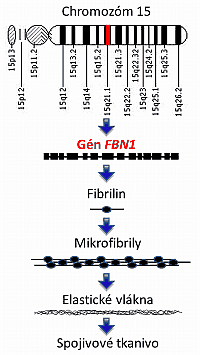Causes
What is Marfan Syndrome?
Marfan Syndrome (MFS; OMIM
154700) is an inherited disease of connective tissues that affects many organs,
including skeleton, heart, blood vessels, eyes and lungs. The disease affects
men and women of any race or ethnic group. One affected person occurs in approximately
3 000 – 5 000 people. The disease was first described by French pediatrician
Antoine Marfan in 1896.
What are the causes of Marfan syndrome?
The disease is caused by a hereditary change (mutation) of the FBN1 gene (OMIM 134797), which is located on chromosome 15. The FBN1 gene contains instructions for the synthesis of a large protein called fibrillin-1. This protein is transported from the cell to the intercellular space (extracellular matrix), a complex network of proteins and other molecules. The extracellular matrix is critical to the structural integrity and functioning of connective tissue. Fibrillin-1 binds with other fibrillin molecules and other proteins to form so-called microfibrils. These are part of elastic fibers that allow the skin, ligaments and blood vessels to expand. They are also found in the pendulum apparatus of the eye lens, in the nerves and muscles. In recent years, the role of microfibrils has also been recognized as a reservoir of multiple growth factors, thus affecting the activation of various signalling pathways. By connecting and disconnecting different types of molecules, such as e.g. transforming growth factor beta (TGFβ), microfibrils are involved in organ development. The FBN1 mutation causes defective fibrillin to alter the mechanical properties of connective tissue and to affect biochemical processes that lead to pathological manifestations in various organ systems. Click here for more information on the FBN1 gene, mutations and DNA assays.
- approximately 75% of patients inherit the disease from a parent who is also affected
- in 25% of cases it is a new mutation, i. the affected child is born to two healthy parents - the damaged gene occurs in a sex cell (egg or sperm)
Inheritance of Marfan syndrome
Marfan syndrome is inherited as an autosomal dominant disease. This means that the gene causing Marfan syndrome is located on chromosome 15, which does not determine sex (called autosome). Chromosomes occur in pairs and hence autosomal genes are found in pairs (two alleles). Persons with Marfan syndrome have one allele normal (healthy) and the other mutant ("damaged"). The mutated allele is dominant and predominates over the normal allele. During maturation of sex cells, a pair of chromosomes are separated into two sex cells. Thus, only one of the alleles "leaves" into the sex cell. The probability that the damaged gene/allele will "arrive" is 1: 1, ie 50%. So a person affected with Marfan syndrome has a 50% probability that each of his children will inherit the disease, regardless of gender. Although each patient with MFS has the same gene damaged, not everyone will have the same symptoms and severity of the disease. This is referred to as "variable expression".
